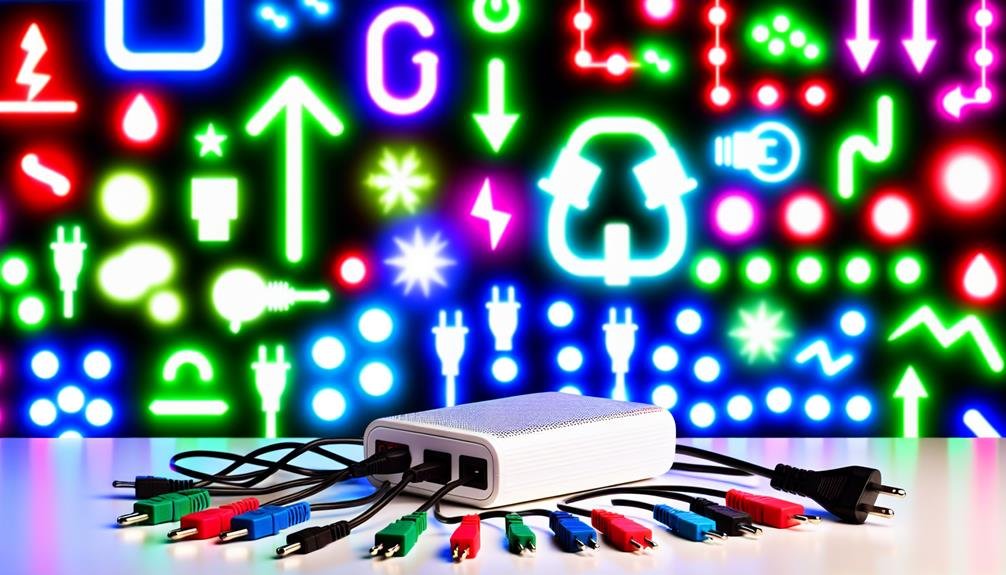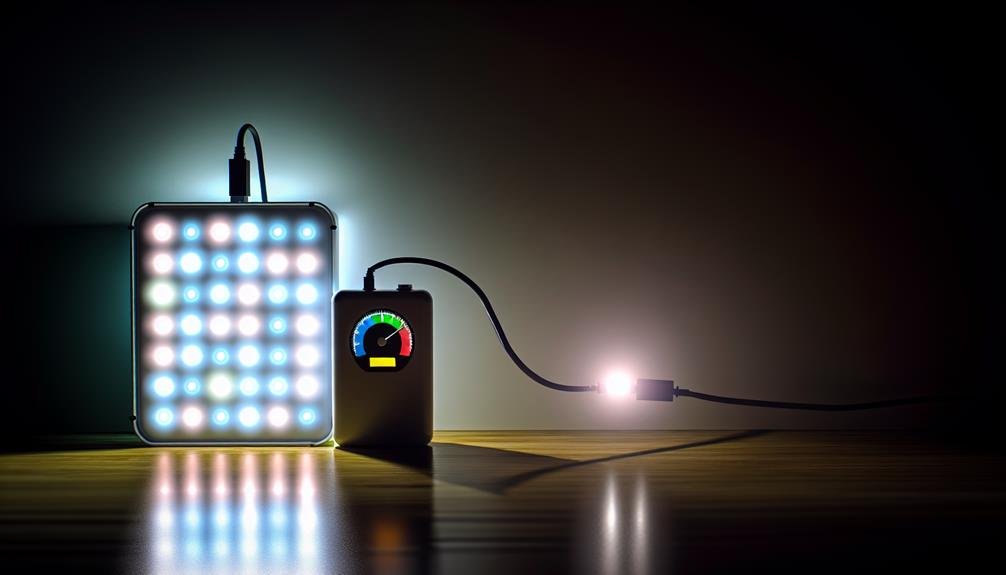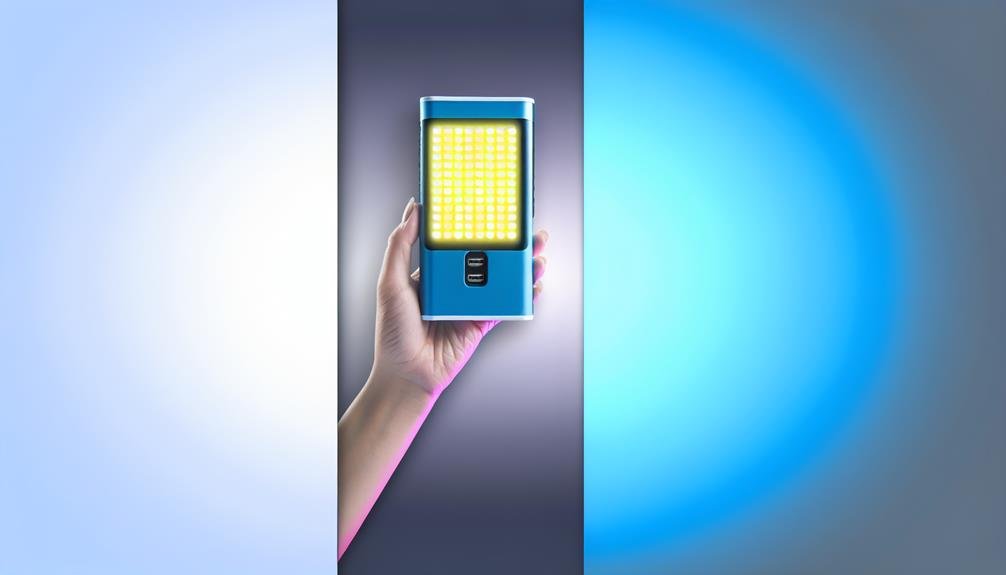Yes, a power bank can power LED lights if it matches the voltage and current requirements. You'll need to make sure your power bank's voltage output is compatible with your LED lights. Check both the power bank's capacity (mAh) and the current rating to determine how long it can run your LEDs. Ensure the power bank's connectors are compatible with the LED lights. Lower wattage LEDs are more energy-efficient, resulting in longer operation times. For effective use, balance all factors like voltage, current, and connector compatibility. To explore practical applications and tips for best performance, there's more to take into account.
Understanding Power Banks

Although power banks are commonly used for charging smartphones and tablets, understanding their specifications and capabilities is necessary when selecting one to power LED lights. You'll need to take into account two important factors: charging capacity and voltage output.
Charging capacity, usually measured in milliampere-hours (mAh), indicates how much energy the power bank can store. For powering LED lights, a higher capacity guarantees longer usage times. For example, a 20,000 mAh power bank can theoretically provide more energy than a 10,000 mAh unit. However, keep in mind that actual performance can vary based on the efficiency of the power bank and the LED lights' energy consumption.
Voltage output is another critical aspect. Most power banks offer a standard 5V output, suitable for many USB-powered devices. However, LED lights may require different voltage levels. Some LED lights operate at 12V or even 24V. Make sure your power bank can either match these requirements directly or use an appropriate step-up converter to adjust the voltage output safely.
Types of LED Lights
When choosing LED lights to pair with your power bank, it's essential to comprehend the different types available, including strip lights, bulb lights, and panel lights, each with distinct power requirements and applications. Strip lights are highly versatile and ideal for accent lighting. They're typically low in energy consumption, making them a good fit for smaller power banks. Pay attention to the color temperature, which can vary from warm white to cool daylight, impacting the ambiance they create.
Bulb lights, on the other hand, are usually brighter and consume more power. They're often used for general illumination in portable lamps or outdoor settings. Evaluating their energy consumption is vital to make sure your power bank can handle the load without depleting too quickly. Color temperature choices here vary widely, allowing you to adapt the lighting to different environments.
Panel lights are designed for more extensive lighting needs, such as in photography or videography. These lights can be demanding in terms of power, so you'll need a high-capacity power bank. Understanding their energy consumption and color temperature options will help you achieve the desired lighting effects while ensuring safety and efficiency.
Compatibility Factors

To guarantee your power bank effectively supports your LED lights, you must evaluate key compatibility factors such as voltage, current, and connector type. First, verify the voltage output of your power bank matches the voltage requirements of your LED lights. A mismatch can lead to inefficiency or even damage to your LEDs. Typically, LED lights operate on low voltage, often 5V, which is commonly supported by power banks.
Next, consider the current rating. LED brightness depends on sufficient current supply. If your power bank can't provide adequate current, your LEDs may dim or flicker. Check the power bank's output current (measured in amperes) and compare it to the LED light's current requirement.
Another critical factor is the connector type. Your power bank and LED lights should have compatible connectors. USB-A or USB-C ports are standard on most power banks and can be adapted to various LED connectors with the correct cables.
Lastly, assess the power bank capacity. A higher capacity power bank (measured in mAh) will guarantee longer operation times for your LED lights, especially if you're using high-brightness LEDs. Balancing these factors will guarantee a safe and efficient power supply for your LED lighting needs.
Power Requirements
Understanding your LED lights' power requirements is crucial for ensuring they operate effectively and safely with your selected power bank. To match the power bank's capabilities with your LED lights, you'll need to take into account several factors:
- Power Consumption: Calculate the total power consumption of your LED lights. This is typically measured in watts (W). Knowing this helps you determine if your power bank can provide enough power to keep your lights on for the desired duration.
- Voltage Requirements: LED lights usually have specific voltage requirements, often listed on the packaging or product manual. Confirm that your power bank's output voltage matches the LED's requirements to prevent underperformance or damage.
- Power Output: Check the power output rating of your power bank, which is usually given in volts (V) and amperes (A). Ensure that it can deliver the required power consistently without overheating or power drops.
- Energy Efficiency: Take into consideration the energy efficiency of your LED lights and power bank. High energy efficiency in LEDs reduces overall power consumption, allowing your power bank to last longer and operate more securely.
Efficiency Considerations

Evaluating the efficiency of your power bank and LED lights is essential for maximizing performance and minimizing energy waste. To achieve this, you need to understand both the power bank capacity and the energy consumption of your LED lights. Start by checking the milliampere-hour (mAh) rating of your power bank; this indicates how much charge it can store. For example, a power bank with a 10,000 mAh capacity can theoretically supply 10,000 milliamps for one hour or 1,000 milliamps for ten hours, though real-world efficiency may vary.
Next, consider the energy consumption of your LED lights, typically measured in watts (W). Lower wattage LEDs consume less power and hence drain the power bank more slowly. To estimate how long your power bank will last, divide its watt-hour (Wh) capacity by the wattage of your LEDs. If your power bank's capacity is 37 Wh and your LED light consumes 3 W, the power bank can theoretically power the light for around 12 hours (37 Wh / 3 W = 12.33 hours).
To ensure safety, always adhere to manufacturer guidelines for both the power bank and the LEDs. Overloading your power bank can lead to overheating and potential hazards.
Practical Applications
Harnessing the power of a well-suited power bank and LED lights can greatly enhance your off-grid lighting solutions, providing both efficiency and reliability. You'll find that this combination is not only practical but also versatile for various scenarios.
- Outdoor Lighting: When camping or hiking, using a power bank to illuminate your path with LED lights guarantees you maintain visibility without relying on disposable batteries or traditional fuel-based lamps.
- Emergency Situations: In the event of a power outage, a charged power bank can act as a dependable backup to power essential LED lights, keeping your surroundings safe and navigable.
- Portable Workspaces: For outdoor projects or remote job sites, a power bank paired with LED lights offers a mobile and efficient lighting solution, ensuring you have the necessary illumination to work safely and effectively.
- Decorative Lighting: For events or gatherings, this setup allows you to create ambient lighting without the need for fixed electrical sources, making it both convenient and adaptable.
When using power banks for these applications, always verify that the voltage and current output match the requirements of your LED lights to prevent any safety hazards. This careful consideration will optimize both the longevity and safety of your lighting solutions.
Pros and Cons

When considering a power bank for LED lights, you'll find significant benefits in portability and convenience, allowing you to use your lights anywhere. However, it's important to weigh the potential impact on battery life, as frequent recharging can reduce long-term performance. Evaluating these factors will help you make an informed decision tailored to your needs.
Portability and Convenience
Due to their compact size and lightweight design, power banks offer unparalleled portability, making them an excellent choice for powering LED lights on the go. Whether you're dealing with emergency situations or attending outdoor events, a power bank can be a reliable source of energy. This convenience not only ensures you're prepared but also minimizes your environmental impact through energy savings.
Pros of Using Power Banks for LED Lights
- Emergency Situations: Handy during power outages or unexpected emergencies, guaranteeing you have light when you need it most.
- Outdoor Events: Ideal for camping, hiking, or any outdoor activity, providing a portable light source without the need for traditional power outlets.
- Energy Savings: Power banks can be charged during off-peak hours, potentially reducing energy consumption and costs.
- Environmental Impact: Utilizing rechargeable power banks reduces the need for disposable batteries, promoting a more sustainable approach to energy use.
Cons
While the portability and convenience of power banks are undeniable, it's crucial to take into account their limitations. The power output may not be sufficient for high-wattage LED lights, and you'll need to regularly recharge the power bank, which could be inconvenient in certain situations.
Battery Life Impact
Understanding the battery life impact of using power banks for LED lights is essential, as it directly affects their efficiency and practicality in various applications. When you connect LED lights to a power bank, energy consumption becomes a vital factor. LED lights are generally energy-efficient, but their cumulative energy draw can greatly reduce the power bank's battery life, especially if used for extended periods.
From a performance impact perspective, the type and capacity of the power bank play important roles. High-capacity power banks can sustain LED lights longer, providing more continuous usage before needing a recharge. Conversely, smaller capacity power banks might drain quickly, limiting the operational time of your LED lights and necessitating frequent recharges, which can be inconvenient.
On the positive side, using a power bank allows for portability and flexibility, enabling you to utilize LED lights in various settings without relying on a fixed power source. However, the downside includes potential performance impact due to rapid battery depletion, which could compromise your lighting needs in crucial situations. Always make sure your power bank is compatible with the energy consumption requirements of your LED lights to maintain optimal performance and safety.
Tips for Optimal Use
To maximize performance of your LED lights with a power bank, you must choose the right power bank with sufficient capacity and output specifications. Regularly monitor the battery life to avoid unexpected power loss and guarantee continuous illumination. Additionally, using efficient LEDs will optimize the power bank's runtime, providing longer-lasting light.
Choose Right Power Bank
When selecting the right power bank for your LED lights, how can you make certain it meets your specific needs for capacity, compatibility, and efficiency? Prioritize the following factors to ensure peak use and safety.
- Charging Capacity: Verify the power bank's milliampere-hour (mAh) rating. Calculate your LED lights' power requirements to determine the necessary charging capacity. For example, if your LED lights consume 5V and 2A, a power bank with 10,000mAh should be sufficient for extended use.
- Voltage Output: Confirm the power bank's voltage output matches your LED lights' specifications. LED lights typically require a stable 5V output. Mismatched voltage can lead to suboptimal performance or damage, making this a critical consideration.
- Compatibility: Check the power bank's ports and connectors to ensure they are compatible with your LED lights. USB-A or USB-C ports are commonly used, but always verify to avoid connectivity issues.
- Efficiency and Quality: Look for power banks with high-efficiency ratings (typically above 85%) and built-in safety features such as overcharge protection, short-circuit prevention, and temperature control. This ensures not only peak performance but also safety during use.
Monitor Battery Life
After selecting a power bank that meets your LED lights' specifications, it's essential to monitor battery life to maximize efficiency and longevity. Start by familiarizing yourself with the battery indicator on your power bank. This tool is vital for gauging how much charge remains and planning your recharging cycles accordingly. Keep an eye on the battery indicator to prevent complete discharge, which can degrade battery health over time.
Consider the various charging options available. Use a charger that matches the power bank's specifications to guarantee a stable and safe recharge. Faster charging may seem convenient, but it can generate excess heat, negatively impacting battery life. Opt for moderate-speed charging to balance efficiency and longevity.
Monitor your energy consumption closely. Different LED lights have varying power requirements, so understanding your usage patterns is essential. If you're using high-wattage LEDs, the power bank will drain quickly, necessitating more frequent recharges. Regularly check how long your LEDs run on a full charge to anticipate when recharging is needed.
Use Efficient LEDs
Choosing energy-saving LEDs can greatly prolong the operational life of your power bank by reducing overall power consumption. By opting for LEDs that maximize energy savings, you'll ensure that your power bank delivers top performance and longevity.
To achieve this, consider the following tips:
- Choose Low Wattage LEDs
Opt for LEDs with lower wattage ratings without compromising on brightness levels. Modern LEDs can provide high lumens per watt, meaning you get more light for less energy.
- Adjust Brightness Levels
Use LEDs that offer adjustable brightness settings. Lowering the brightness when full intensity isn't needed can remarkably cut down on energy usage, thereby extending your power bank's life.
- Check for Efficiency Ratings
Look for LEDs with high efficiency ratings, such as those certified by ENERGY STAR. These LEDs are designed to use less power while providing the same level of brightness, ensuring maximum energy savings.
- Use Quality Drivers
Ensure your LEDs have high-quality drivers, which regulate the power supply efficiently. Poor-quality drivers can lead to energy wastage and reduce the overall efficiency of your setup.
Frequently Asked Questions
How Long Can a Power Bank Run LED Lights Continuously?
The usage duration of LED lights powered by a power bank depends on battery capacity and efficiency. For best performance and safety, calculate your power bank's mAh rating and divide it by the LED lights' wattage consumption.
Are There Specific Brands of Power Banks Better for LED Lights?
When examining power bank compatibility with LED lights, consider the best power bank brands like Anker, RAVPower, and Aukey. They offer reliable performance, ensuring your LED lights run safely and efficiently without unexpected interruptions.
Can a Power Bank Charge and Power LED Lights Simultaneously?
If your power bank has compatibility for both charging and output, like the Anker PowerCore, you can charge it and power LED lights simultaneously. Guarantee it can handle maximum brightness without overheating to maintain safety.
Do LED Light Colors Affect Power Bank Battery Life?
Yes, LED light colors can impact battery life. Different colors have varying efficiency and power consumption. Blue and white LEDs typically consume more power, reducing battery life, while red and green LEDs are more efficient.
Is There a Risk of Overloading a Power Bank With Multiple LED Lights?
Think of your power bank like a dam holding water. There are power bank limitations; connecting too many LED lights can overflow it, risking LED light safety. Always check the power bank's capacity to prevent overload.



